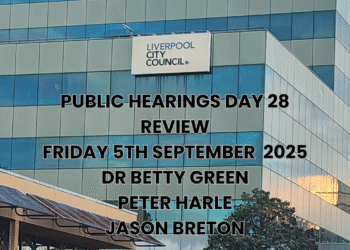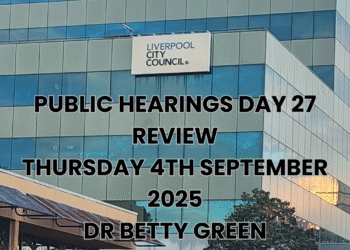Apologies for the delay in posting our Day 6 review. Matters relating to confidentiality meant that the transpcript was withheld from the public unitl an outcome was reached.
The day 6 session started with a quick administrative update. Mr J Emmett SC, counsel for Liverpool City Council, confirmed they no longer sought to maintain confidentiality orders from a closed session on the previous day, allowing that transcript to be made public after a formal process post-morning tea. The focus then shifted to Mr Vishwa Nadan, Chief Financial Officer at the council, who continued his testimony from the day before under his previous oath.
Mr Nadan’s evidence on Day 6 zeroed in on the council’s financial health, budget forecasts, and the measures being taken to address ongoing deficits. We have tried to break it down into plain language, spotlighting the bits that should worry us most as ratepayers footing the bill for a budget exceeding $530 million a year.
Budget Forecast: From Deficit to Small Surplus, Then Back Again
Mr Nadan discussed the council’s long-term financial plan for 2026-2035, highlighting a concerning pattern. For the 2024/25 financial year, the council recorded a deficit of about $5.9 million. The current 2025/26 budget predicts a small surplus of $800,000, achieved through specific measures like a second round of staff redundancies (tranche 2) and expected funds from a legal settlement with Canterbury-Bankstown Council over bridge repairs. This settlement, backed by a deed of agreement, is set to be finalised within six months, though the exact amount remains confidential for now due to commercial sensitivity.
However, what’s really troubling for us ratepayers is that after this brief surplus, the forecast slips back into deficits for several years. Mr Nadan explained this is due to one-off gains—like the bridge money—not repeating, alongside an assumption that rental income from a major property, earmarked for sale per a 2023 council resolution, will stop by 2027/28, worsening the deficit. This property sale is tied to repaying a $23 million loan for Civic Place, showing how reliant the council is on asset sales to manage debt. For residents, this ongoing deficit trend signals financial instability, raising fears that our rates might climb or services to balance the books.
To reach the $800,000 surplus for 2025/26, Mr Nadan outlined two big moves. First, tranche 2 redundancies are planned, following tranche 1 last year which saw two directors and two executive assistants let go. A $2 million provision was set aside in 2024/25 for these payouts, covering both tranches unless costs exceed this, in which case extra expenses will hit the 2025/26 budget directly from cash reserves.
Secondly, Mr Nadan identified $5 million in savings through a detailed line-by-line budget review for 2025/26, separate from the big-ticket items like redundancies or bridge funds. This involved looking at past spending trends over three years on things like security or cleaning contractors and negotiating realistic budgets with directors—often reducing allocations if prior years showed underspending. While not outright cuts, it’s about setting tighter, more accurate figures. However, as ratepayers, we should worry if these ‘realistic’ budgets underestimate actual needs, risking underfunded services or unexpected costs later that could again push up rates.
Mr Nadan described new steps to ensure savings stick, including having directors sign agreements confirming they’ll stick to their budgets—a first for 2025/26. Finance teams also provide monthly updates to executives and the governance committee, plus quarterly public budget reviews. Finance business partners work with directors to spot variances early and find alternative savings if needed. However, Mr Nadan admitted these reporting mechanisms have been in place for years and still haven’t stopped past budgets sliding from surplus to deficit due to external factors like reduced federal funding (e.g., getting 50% instead of an assumed 85% advance, creating a $3.7 million hole last year).
A budget deficit certainly results in less money for community projects or infrastructure, and we might end up paying more through rates or seeing services trimmed to cover these gaps across Liverpool’s suburbs.
Unlike previous budgets that leaned on property sales like 3 Hoxton Park Road to boost numbers (as raised on Day 5), Mr Nadan confirmed this approach was dropped for 2025/26. Instead, the focus is on redundancies, bridge settlement funds, and operational savings. The reliance on one-off gains (like the bridge money) and job cuts rather than sustainable revenue sources suggests the council might be scrambling for quick fixes rather than building long-term stability. Plus, the lack of clarity on future property sales tied to debt repayment (like the unnamed major property) keeps us in the dark about how our assets are being managed.
As Liverpool ratepayers, we’re funding a council wrestling with a shaky financial outlook, and Day 6’s testimony from Mr Nadan lays bare some harsh realities. The persistent deficits forecast after a fleeting 2025/26 surplus are a major worry—our rates could rise or services could suffer if the council can’t find steady income beyond one-off windfalls or staff cuts.Even more troubling is the admission that past monitoring failed to stop budget shortfalls, casting doubt on whether new accountability measures like director sign-offs will work. If external shocks like reduced federal funding keep punching holes in the budget, we’re the ones who’ll bear the cost through higher charges or reduced amenities. And with strategies shifting away from property sales but still banking on uncertain settlements, there’s a lack of transparency and long-term planning that leaves us questioning if our money is actually being handled wisely.
Don’t forget to tune in to 89.3 every Thursday at 9am with Michael and BJ on The Pulse for the latest local news and updates on these hearings.



























